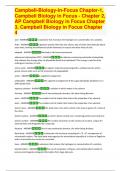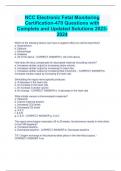Campbell-Biology-in-Focus Chapter-1,
Campbell Biology in Focus - Chapter 2,
AP Campbell Biology in Focus Chapter
3, Campbell Biology in Focus Chapter
4
acid - ANSWER A substance that increases the hydrogen ion concentration of a solution.
Actin - ANSWER A globular protein that links into chains, two of which twist helically about
each other, forming microfilaments (actin filaments) in muscle and other kinds of cells.
adapted - ANSWER Matched to the local environment.
adenosine triphosphate (ATP) - ANSWER An adenine-containing nucleoside triphosphate
that releases free energy when its phosphate bonds are hydrolyzed. This energy is used to drive
endergonic reactions in cells
amino acids - ANSWER An organic molecule possessing both a carboxyl and an amino
group. Amino acids serve as the monomers of polypeptides
anion - ANSWER A negatively charged ion.
antiparallel - ANSWER The opposite arrangement of the sugar-phosphate backbones in a
DNA double helix.
aqueous solution - ANSWER A solution in which water is the solvent.
Archaea - ANSWER One of two prokaryotic domains, the other being Bacteria.
atom - ANSWER The smallest unit of matter that retains the properties of an element.
atom - ANSWER The smallest unit of matter that retains the properties of an element.
atomic mass - ANSWER The total mass of an atom, which is the mass in grams of 1 mole of
the atom.
atomic nucleus - ANSWER An atom's dense central core, containing protons and neutrons.
atomic number - ANSWER The number of protons in the nucleus of an atom, unique for
each element and designated by a subscript.
Bacteria - ANSWER One of two prokaryotic domains, the other being Archaea.
Basal body - ANSWER A eukaryotic cell structure consisting of a "9 + 0" arrangement of
microtubule triplets. The basal body may organize the microtubule assembly of a cilium or flagellum
and is structurally very similar to a centriole.
base - ANSWER A substance that reduces the hydrogen ion concentration of a solution.
bioinformatics - ANSWER The use of computers, software, and mathematical models to
process and integrate biological information from large data sets.
,Campbell-Biology-in-Focus Chapter-1,
Campbell Biology in Focus - Chapter 2,
AP Campbell Biology in Focus Chapter
3, Campbell Biology in Focus Chapter
4
biology - ANSWER The scientific study of life.
biosphere - ANSWER The entire portion of Earth inhabited by life; the sum of all the
planet's ecosystems.
buffer - ANSWER A solution that contains a weak acid and its corresponding base.
Minimizes changes in pH when acids or bases are added to the solution.
calorie - ANSWER The amount of heat energy required to raise the temperature of 1g of
water by 1C; also the amount of heat energy that 1 g of water releases when it cools by 1C.
carbohydrates - ANSWER A sugar (monosaccharide) or one of its dimer (dissacharides) or
polymers (polysaccharides)
catalysts - ANSWER A chemical agent that selectively increases the rate of a reaction
without being consumed by the reaction
cation - ANSWER A positively charged ion.
cell - ANSWER Life's fundamental unit of structure and function.
Cell fractionation - ANSWER The disruption of a cell and separation of its parts by
centrifugation at successively higher speeds.
Cell wall - ANSWER A protective layer external to the plasma membrane in the cells of
plants, prokaryotes, fungi, and some protists. Polysaccharides such as cellulose (in plants and some
protists), chitin (in fungi), and peptidoglycan (in bacteria) are important structural components of cell
walls.
Cellulose - ANSWER A structural polysaccharide of plant cell walls, consisting of glucose
monomers joined by β glycosidic linkage
Central vacuole - ANSWER In a mature plant cell, a large membranous sac with diverse roles
in growth, storage, and sequestration of toxic substances.
Centriole - ANSWER A structure in the centrosome of an animal cell composed of a cylinder
of microtubule triplets arranged in a 9+0 pattern. A centrosome has a pair of centrioles.
Centrosome - ANSWER A structure present in the cytoplasm of animal cells that functions
as a microtubule-organizing center and is important during cell division. A centrosome has two
centrioles.
, Campbell-Biology-in-Focus Chapter-1,
Campbell Biology in Focus - Chapter 2,
AP Campbell Biology in Focus Chapter
3, Campbell Biology in Focus Chapter
4
chemical bond - ANSWER An attraction between two atoms, resulting from a sharing of
outer shell electrons or the presence of opposite charges on the atoms. The bonded atoms gain
complete outer electron shells.
chemical equilibrium - ANSWER In a chemical reaction, the state in which the rate of the
forward reaction equals the rate of the reverse reaction, so that the relative concentrations of the
reactants and products do not change with time.
chemical reaction - ANSWER The making and breaking of chemical bonds, leading to
changes in the composition of matter.
chitin - ANSWER A structural polysaccharide consisting of amino sugar monomers, found in
many fungal cell walls and in the exoskeletons of all arthropods
Chloroplast - ANSWER An organelle found in plants and photosynthetic protists that
absorbs sunlight and uses it to drive the synthesis of organic compounds from carbon dioxide and
water.
cholesterol - ANSWER A steroid that forms an essential component of animal cell
membranes and acts as a precursor molecule for the synthesis of other biologically important
steroids, such as many hormones
Chromatin - ANSWER The complex of DNA and proteins that makes up eukaryotic
chromosomes. When the cell is not dividing, chromatin exists in its dispersed form, as a mass of very
long, thin fibers that are not visible with a light microscope.
Chromosome - ANSWER A cellular structure consisting of one DNA molecule and associated
protein molecules. (In some contexts, such as genome sequencing, the term may refer to the DNA
alone.) A eukaryotic cell typically has multiple, linear chromosomes, which are located in the
nucleus. A prokaryotic cell often has a single, circular chromosome, which is found in the nucleoid,a
region that is not enclosed by a membrane.
Cilium - ANSWER A short appendage containing microtubules in eukaryotic cells. A motile
cilium is specialized for locomotion or moving fluid past the cell; it is formed from a core of nine
outer doublet microtubules and two inner single microtubules (the "′9+2" arrangement) ensheathed
in an extension of the plasma membrane. A primary cilium is usually nonmotile and plays a sensory
and signaling role; it lacks the two inner microtubules (the "9+0" arrangement)
cohesion - ANSWER The linking together of like molecules, often by hydrogen bonds.
Collagen - ANSWER A glycoprotein in the extracellular matrix of animal cells that forms
strong fibers, found extensively in connective tissue and bone; the most abundant protein in the
animal kingdom.





